If “simplicity is the ultimate sophistication,” the Stevens 301 single shot is about as sophisticated as it gets. The new offering from Savage Arms revives the classic design in three of the most popular shotgun calibers: 12 gauge, 20 gauge and .410.
Whether you’re a survivalist looking for a trail gun or a parent looking for a first firearm, the 301’s low cost, simple functionality and reliability make it a great addition to any collection.

The front bead sight was easy to see in the fading light, and the Model 301’s light weight allowed for quick handling.
SPECS
Bore: 12 gauge (tested); 20 gauge; .410 bore (tested)
Stock Material: Synthetic
Weight: 5.8 lbs. (12 gauge); 4.8 lbs. (.410)
Barrel Material: Carbon Steel
Barrel Finish: Matte
Barrel Color: Black
Barrel Length: 26 in.
MSRP: $173
Manufacturer: Savage Arms
Stevens Going Savage
Savage bought the Stevens brand in 1920 but stopped manufacturing firearms under that name in 1991. Savage revived the Stevens Series in 1999 and has since been manufacturing reliable, low-cost rifles and shotguns under the Stevens trademark.
Savage offers the Model 301 in both standard and compact sizes. The standard size comes in 12 gauge, 20 gauge and .410 bore. The compact size, intended for younger or smaller shooters, is available in 20 gauge and .410 bore. The standard size features a 26-inch barrel and the compact size features a 22-inch barrel.
Features and Functionality
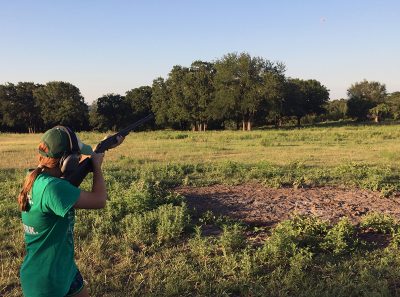
The author’s niece did a great job with the .410. She started shooting balloons with bird shot, but by the end of the afternoon she was hitting iron targets with slugs.
Youngsters have been learning to shoot with single-shot .410 shotguns for decades, and that trend will no doubt continue with the easy-to-use Stevens 301. A takedown lever located to the right of the hammer allows the shooter to swing the barrel forward and expose the chamber. Shells are loaded one at a time and fired by cocking the hammer and simply squeezing the trigger.
The safety is located on the left side of the firearm. I found it to be a bit loose, and it lacked a firm, tactile click when engaged and disengaged. Still, it functioned as it was supposed to and kept the hammer from striking the firing pin.
The 301’s simple break down is one of my favorite features. A button located on the front of the handguard allows the shooter to remove the guard and lift the barrel out of the stock. The handguard can then be reinstalled to the barrel, so the gun consists of two pieces rather than three.
Survivalists love rifles like the .22-caliber Henry AR-7, and with good reason. But if you need to survive two weeks in the woods, you might also consider the Stevens 301 in .410. The shotgun fits easily into a backpack after removing the barrel, and the ability to shoot both birdshot and slugs allows for the harvesting of a wider variety of game. The simple design makes it nearly fail-proof and the carbon steel barrel makes it extremely rugged. Plus, with an MSRP of $173, you can probably afford to buy a backup 301 for the price of many survival rifles.
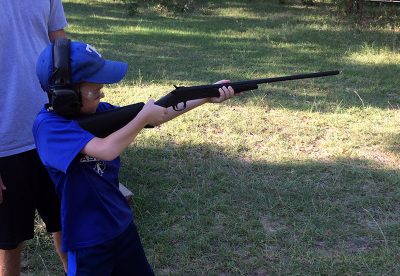
The standard size 301 was a bit too big for the author’s nephew, but he hung in there and did his best.
Range Time
I tested the standard size 301 in 12 gauge and .410 over the course of several days and hundreds of rounds. The guns are identical, notwithstanding the barrel diameters. I was especially curious to see the patterning the guns produced, as single-shot shotguns allow for longer barrels with shorter overall lengths compared to other types of actions. Pump, lever, and semi-automatic actions take up space between the barrel and the stock, space that break-action shotguns use to increase barrel length.

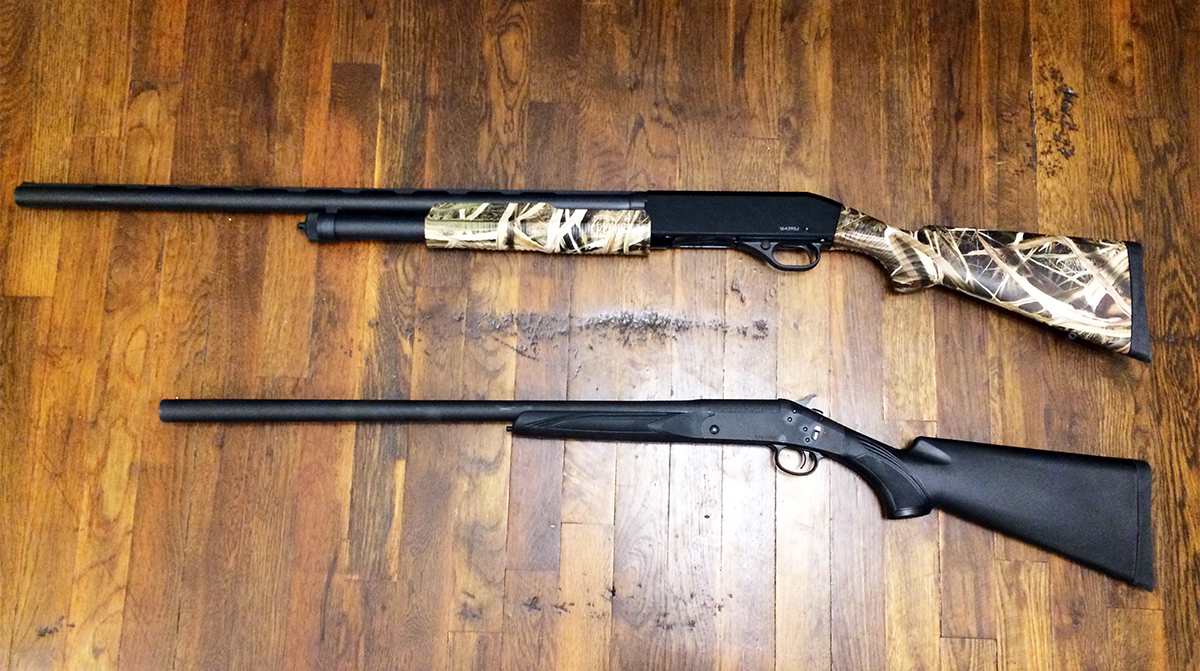
Even the standard size 301 is much more compact than pump action shotguns that feature barrels of similar lengths.
Both of these scatterguns featured 26-inch barrels with overall lengths of 41 inches. For comparison, the Stevens 320 I reviewed last month has a barrel length of 28 inches with an overall length of 48 inches. The barrel on the 301 is only 2 inches shorter, but the overall length is 7 inches shorter, as you can see in the picture.
I shot patterns at 15, 25 and 35 yards with both the 12 gauge and .410 bore using a modified choke. In the 12 gauge, I used 1 1/8 ounce Federal Gold Medal Grand target loads and Federal Premium 00 buckshot. In the .410, I used 11/16 oz. Federal High-Brass loads and Federal Premium 000 buckshot.
I was pleased with the patterns both gun produced. The spreads with the target loads were good at 15 and 25 yards. The 12 gauge produced a 14-inch spread at 15 yards and a 23-inch spread at 25 yards. The .410 produced a 12-inch spread at 15 yards and a 26-inch spread at 25 yards. The 12 gauge obviously performed better than the .410 at 35 yards, but my targets were not large enough to get an accurate spread measurement. Still, you can see that both guns spread the shot evenly across the targets, and the diameters appeared to be consistent with what I would expect with a modified choke at 35 yards.
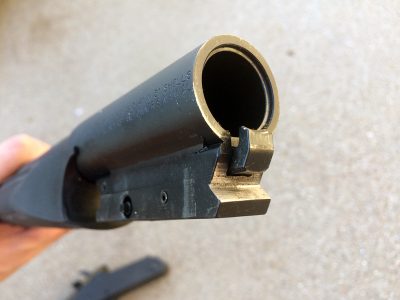
The 301’s single-shot, break-action design makes it ultra-reliable. There are very few moving parts, which lessens the chance that the gun will malfunction. The shotgun breaks down into three major parts: the barrel (pictured), the action and the forend.
Shootability
Both guns are fun to shoot, but the 12 gauge delivers a bit more felt recoil than other shotguns I’ve tested. This isn’t surprising, given its 5½-pound weight and compact package. I enjoyed shooting target loads, but buckshot and slugs left my shoulder throbbing. The gun doesn’t include a robust recoil pad, and the break-action design transfers all the energy from the load straight back into the stock.
Also keep in mind that shouldering the 301 might feel strange if you’re used to a pump action or a semi-automatic. Because there’s no need for a receiver, the handguard doesn’t extend as far forward as most pump-action shotguns. This reduces the overall length of the gun, but it takes time to acclimate to the shorter dimensions.
Still, the 12 gauge handled nicely during my clay shooting session, and I always enjoy the tactile, hands-on experience of unloading and loading each individual shell.
The .410 was the real highlight of the day. As these guns are geared towards youngsters, I wanted to get some feedback from someone whose parents might consider purchasing the 301 as their child’s first gun. My sister-in-law’s younger siblings were kind enough to help me with this review, and we spent a fantastic afternoon shooting tin cans, balloons, and once they acclimated to the firearms, clay pigeons.
My niece is 13 years old and my nephew is 11. We began by letting each of them shoot stationary targets with the .410. My niece had recently attended a marksmanship clinic, so she had no trouble with the gun. Both the action and the hammer are fairly stiff, though, so at times, she struggled at times to load the shells. But she always managed to chamber and fire a new round without any help, and the recoil was manageable. She also fired a few slugs and didn’t feel much difference.
The Model 301 gave my 11-year-old nephew a challenge. The recoil affected him much more than his sister. Again, the break-action design transfers quite a bit of energy from the round to the stock to the shooter’s shoulder. He opted for the .22 lever gun my father-in-law had brought to the range after a few rounds.
It’s worth noting that my nephew may have enjoyed the compact 301 more than the standard size. The gun was clearly a bit too big for him, and the shorter barrel would have allowed him to hold the gun more
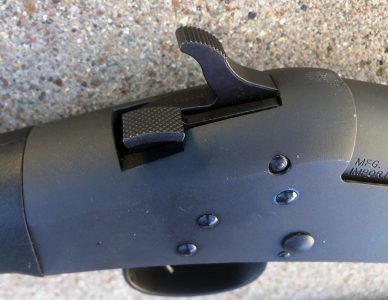
To break open the single-shot .Model 301, simply actuate the small lever on the right side of the hammer.
easily and maintain a more solid shooting base. Once we had destroyed every tin can and balloon in sight, we moved to the back pasture to shoot clays.
Once we had destroyed every tin can and balloon in sight, we moved to the back pasture to shoot clays. I also tried my hand with the 12 gauge, and after some practice I was able to hit with my usual consistency.
Lasting Impressions
For the price, it’s tough to beat the Stevens Model 301 in terms of simplicity, reliability, and function. We experienced no malfunctions during the course of our testing, and both guns performed well.
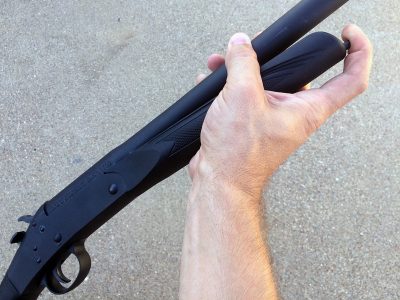
The simple take down method and ease of reinstallation makes the Model 301 ideal as a backpacking firearm.
The 301’s ability to break down quickly and easily makes it ideal for camping and hiking. I think the .410 would perform especially well in a survival situation, given its light weight and the wide variety of loads it can shoot.
The .410 is also a nice option for young shooters. The Stevens 301 provides a fun, simple introduction to the wonderful world of shotguns.
To learn more about the Stevens Model 301, click https://www.savagearms.com/firearms/model/Stevens301.
To purchase a Stevens shotgun on GunsAmerica, click https://www.gunsamerica.com/Search.aspx?Keyword=Stevens.

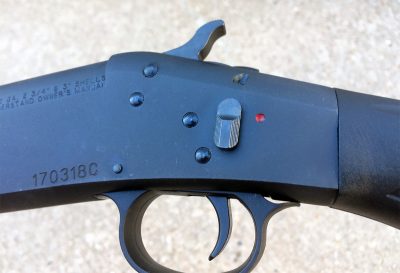
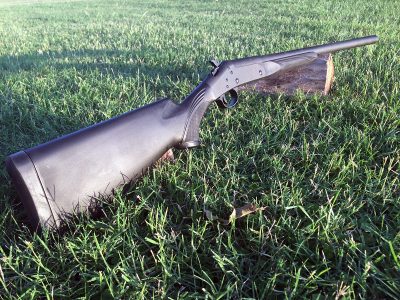
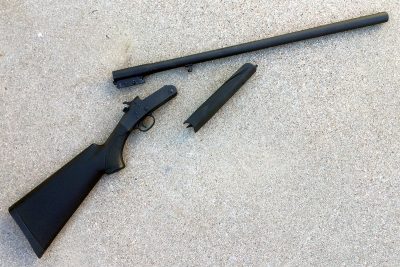
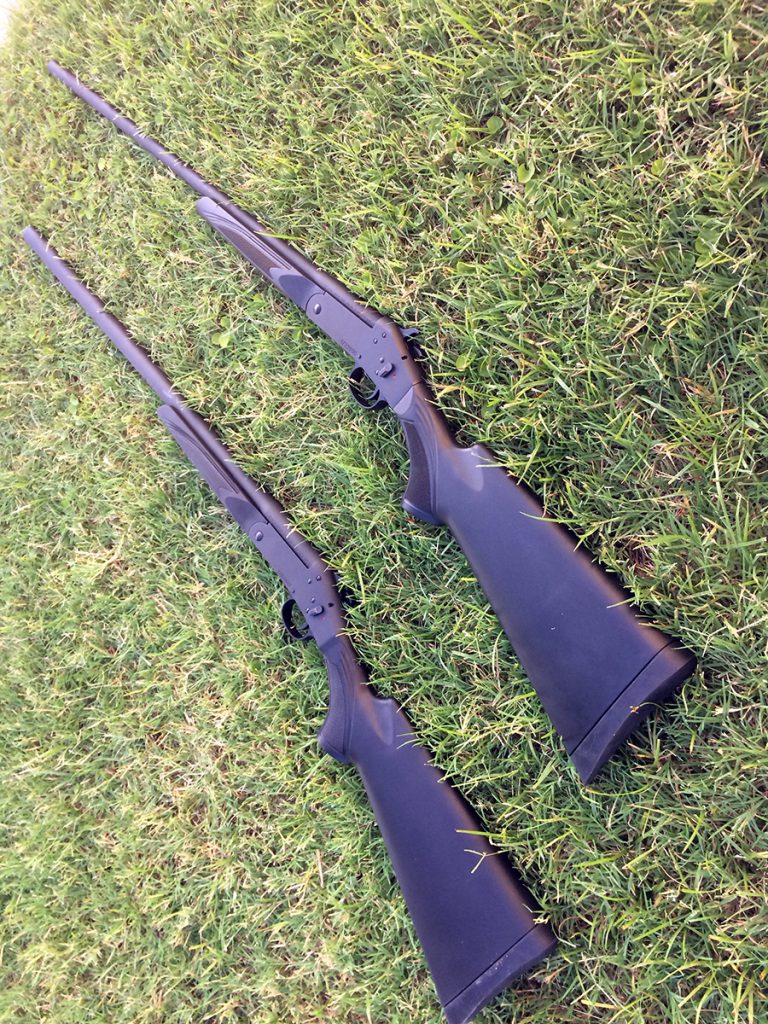
Hi all, still waiting for the compact 410 for my 8 year old… has anyone tried wether or not invector chokes fit in these, and If I can shoot 3 inch steel shot in this without wrecking it?? I can’t find much info on this, not even an owner’s manual.
Thanks
Does this come drilled and tapped to put any kind of optic on there? I’m thinking of this for my kid’s first turkey gun.
Looking for 3 old 1940’s or 50’s Stevens 12 ga. 20 ga. and 410 to redo and keep as a memory of all the joys I gained from as a youngster as a small game hunter. Would be thankful for any info.
Does anyone, ANYONE, know of a set of choke tubes that fit this in .410?? I have been looking everywhere for a set for my daughter’s .410, and can’t find them anywhere. Even Savage can’t help. Any help would be extremely appreciated.
I too am looking for a set of chokes for this gun. It says it takes WIN-Chokes … Is that the same as invector?
I Have been looking for a set for a good while as well. The owners manual on 301 states that chokes can be purchased on the savage website…HaAa ! Yeah right that dint have nothing. Best bet is to google search .410 WinChoke you somtimes get lucky and find an oneline vendor who sells them. You may however be limited to Modified and Full I’ve had a hard time finding anything other…but with. 410 I cant see any reason to use any other choke. Good luck!
Would the Standard or Compact make a better truck gun? I dont have a backseat. i have a jump seat in the back of my S10. I plan to have it under a blanket in the cab but want to know what will fit better?
Compact would be easier to get turned around inside the vehicle. I can’t count the number of times my grandpa (who had an 870 on the rack in his ’70 Chevy C10) would go in with the barrel pointed left only to have to back out, turn the thing around, and put it back the ‘right way.’ The regular Stevens 301 has a 41-inch overall length and 37 inches for the compact, so about 6-10 inches shorter than a typical 870 express model. A standard 10/22 carbine is 37 inches, which is the same length as the compact. How much does pattern matter to you? If you want to be effective at longer ranges, get the standard length. If it’s just for shooting rattle snakes, go with the compact.
The thing that aggravates me about this shotgun is that Stevens (or H&R for that matter) will not make an appropriate frame size for the .410 bore shotgun. They insist on using a 12 gauge frame which translates into unnecessary bulk to be packed around the field. I started my boy out with a 20 gauge shotgun and I’m glad I did. Years later when he transitioned to a 12 gauge 1100, he was right at home. So that leaves us old duffers packing around a whole lot of extra weight & for what? My Cooey 37A seems to fit the bill quite nicely. I had a very early, plastic stocked Stevens 97 that was almost worn out so I sold it before it fell apart in my hands. I’ve had multiple H&Rs, but for the moment, what I’ve got seems to be okay. That safety on the gun tested is very foolish. This only goes to prove how decisively things can go to hell when lawyers rule the roost.
The Steven 301 uses a small .410 sized action. It is petite. It doesn’t use a 12 gauge sized action.
I’ve been coaching trap/skeet youth shooters for over 15 years. My worst nightmare is when mom/dad/grandpa/etc. bring in a tiny little kid with a single shot, hammer-fired, lightweight .410. They are hard for kids to cock, kick like a mule, and a .410 is a gun for experts, not beginners.
There are much better choices out there. Think about it – more weight = less recoil. Better gun fit = less recoil. Semi-auto = less recoil. Buy a youth gun that fits, and in 20 or 12 gauge. If the kid can’t properly hold it, they simply aren’t old enough yet. I have a 10 year old on my team shooting a cut-down 20 gauge over/under. And he is small for his age. And he shoots better and is safer than a lot of adults. I don’t even allow a gun with an external hammer on my team.
But if you want your kids to develop bad habits, flinch, get bruised, and most importantly discouraged because they can’t hit anything with a .410; then go ahead and buy them a gun like this. Just be prepared to cock it for them and watch them become uninterested in shooting…..
I don’t agree with your take on this but each their own right? I grew up shooting 20ga and 12ga. I remember when I was 9 I borrowed a single shot 410 that was my grandpas and it kicked like a 22. Compared to my Browning 20ga pump it was fun to shoot and for a little guy of 9 it was easier for me to handle.
Would be a very nice shotgun if not for the safety on a hammer gun. Marlin and Winchester did this . I and many older shooters have stayed away from these models not finding any reason for these buttons and levers. Enough said.
The receiver is identical to the H&R / NEF single-barrels, down to the placement of the pins. The gun is not very much like my vintage Stevens 94 at all. That’s not a criticism, it’s an observation.
It has a fairly powerful ejector (not extractor). It kicks both my reloads (both Federal and Winchester hulls) clear without a problem.
For my $0.02, and I’ve had guns with all three forearm styles, the push-button takedown on the new 301 is much better than either a screwed-on or popped-on forend. It provides a very positive retention for the barrel to the hinge pin and makes breaking the gun down for transportation or cleaning a breeze.
Yes, the safety on a hammer gun is superfluous but my guess is that it is something the lawyers insisted on.This is a very litigious society we live in and if someone shot their toe of with the gun there would be some silly lawyer who’d be quick to take the case on a “contingency basis” and then claim to the jury that if the gun had had a safety the accident never would have happened. And sadly there are plenty of people in this country that would believe it.
thankfully i made a habit of finding and fixing up used h&r/nef singles when they could be reasonably had at pawn and gun shops. i wonder how this stevens single compares with a rossi single? while i dont need another plain vanilla single by stevens, a 410/45lc survivor model would be attractive. i have a used folding single made in turkey under the brand name khan. it would be very handy as a trunk gun secured in a gym bag except it has an extractor, not auto ejector, to clear spent shells, which makes it much slower to run.
The Rossi has a huge extractor that extends into the chamber by more than 1/4″ not just the rim. Some brands with low brass expanded into that extractor area and stuck in the chamber. So skip the Rossi singles. My example was a 410. I have seen Turkish examples with that same extractor/ejector cut and they would behave the same imo. This Stevens looks like it has the traditional extractor/ejector on mostly just the rim so should be less ammo sensitive in that regard.
I have put my 20 gauge Model 301 next to a 20 gauge H&R and the only differences between the two receivers are the safety and the finish (coated vs. case hardened). Size and shape are identical. Even the placement of the pins is the same.
This gun is simply a modified H&R/NEF SB1, the 301 barrel will fit an SB1 action with only minor fitting (if any). I’m wondering if Savage was bought out by the same conglomerate that bought Remington, Smith & Wesson, Marlin, H&R, NEF, TC, etc. The SB1 was produced under the Marlin name for a year or two before it disappeared. I assume the gun is made in China by Sun City Machinery and imported by Savage.
I have my late dad’s restocked Stevens 22-410 that he got for his 10th birthday in 1940. It is a really sweet piece that everybody gets a kick out of.
I have the 301 compact (22-inch barrel) in 20 gauge. The author did not mention the fact that the gun is set up for choke tubes, and ships with a modified choke tube. Push button take down, interchangeable choke tubes – it doesn’t get any more versatile than that. As for the safety, I switched it off the day I got the gun and haven’t touched it since as it is totally unnecessary unless you like to carry the gun cocked and with your finger on the trigger, in which case a mechanical safety is not going to save you from your own stupidity.
Thanks for pointing out that the gun is set up for choke tubes. Takes the gun from not interesting to very interesting.
The 301 is manufactured in China by Sun City Machinery and is basically a copy of the H&R/NEF SB1 with a push button takedown forearm and the addition of a safety.
I will never understand why gun companies that “revive” older discontinued models seem to always make stupid improvements to them. A side safety is ignorant on this gun. The hammer serves this purpose just fine. Plus why did they do away with the swing opening lever behind the hammer as on the original models? That seems to work just fine on almost all models of over/under shotguns still being produced by the likes of Browning and SKB. We also don’t need a “takedown” button on the tip of the forearm. The way the originals “popped” down and “snapped” back into place during reassembly was classic. Nothing was said about the ejector. Does it throw the empty clear or do you manually remove the fired shell?
If you are going to revive a model, then bring it back exactly as it once was. At least Remington still makes the 870 look and function just like they did 50 years ago.
Indeed, you would think the writer would comment about “ejector” or “extractor” regarding empty removal. Sort of a standard in break-open reviews, regardless of the number of barrels.
Why would anyone put a safety on an external hammer single shot shotgun?
Hey Dude I agree That idiot safety ,plastic wood, and made in CHINA = Don’t want to buy one,and .410 is my favorite shotgun gauge !!
YOU MIGHT LIKE THIS ONE .. I DID NO HAMMER , SAFETY ON TRIGER GUARD, AND WALNUT STOCK
Name: TRS STALKER YTH 410 22″ 1RD BLK WLNT
Item Number: 0142227 Manufacturer: TR IMPORTS
MSRP: 205 EA Model Number: TK3622Y
UPC: 856953002970
SILVER EAGLE®
STALKER SINGLE SHOT SHOTGUN YOUTH MODEL by T R IMPORTS INC.
•Single-shot break-open
•Black aluminum alloy receiver
•Hammerless design
•Extractor
•Ventilated rib blued barrel
•Fiber optic bead sight
•Cross-bolt safety
•Ergonomic Turkish walnut stock & forend
•Textured gripping surfaces
Another “sterling” review. I get sooo tired of them. So many are 5 star reports they all become worthless. Personally, the safety is a big mistake as others have reported. Second, I would NEVER want a gun like this for hunting, survival. In a 12 ga it must kick like a mule. One kick, one blast, and the carnivore, thug, muslim will take you out while you fumble to reload. May as well get a muzzle loader. The market is full of better breakdown survival weapons. I would never train a kid with a .410 single shot. Start them on a reasonable gun; 20, 16 at least a double barrel, pump, auto. Horrible review on a horrible choice. Wasted my time. Why all the hoot and holler about a crappy gun? single shot, .410?
Not all people can let a hammer down safely! my wife has a thumb with not feeling and she would love this gun,and if it is a good safe the gun could be carried cocked.
Any idea where this was manufactured? Usa, Canada, etc? Really want one for my son but dont want any turkey/russia/type stuff.
Looks like CHICOPEE FALLS, MASS
From one of the photos above, looks like:
“MFG By Sun City Machinery Co., LTD In P.R.C.
Imported by Savage Arms Inc. Westfield, Mass, USA”
(P.R.C. – Peoples Republic of China)
If you’re only xenophobic about Russians and Turks then you’re in luck! It’s most likely made by a company called Sun City Machinery in China like my 320 pumper (a pretty decent truck gun you don’t have to worry about–yep it’s no work of art but can’t complain for under $200).
Ugh, China. Even worse since I just found out H&R/NEF went under last year. Guess I will keep looking.
I don’t think NEF/H&R went out. They were a part of the Ceberis/Freedumb group thing like Rem,Moss, B Master, dpms,Cobb, Marlin. All the companies they have touched have turned to crap or are no longer making.
Quality is not at all bad on the 301 I have. It’s a polymer stock and a coated finish on the metal, which I was not crazy about, but the casting on the stock is clean and crisp and everything matches up without gaps. Lockup is positive and it breaks open as it should with no wobbles. The trigger is actually very good – not too heavy and with a clean break. I got it for $170 with shipping and FFL paperwork, and the value is definitely there. Do I wish it were made in the USA? Absolutely.
If you want made-in-America single shot break action, Henry is the way to go. I don’t know anything about them (fit/finish/feel/reliability) other than where they are made. And you will pay a lot more for them, $427 (Henry) vs $173 (Stevens) MSRP.